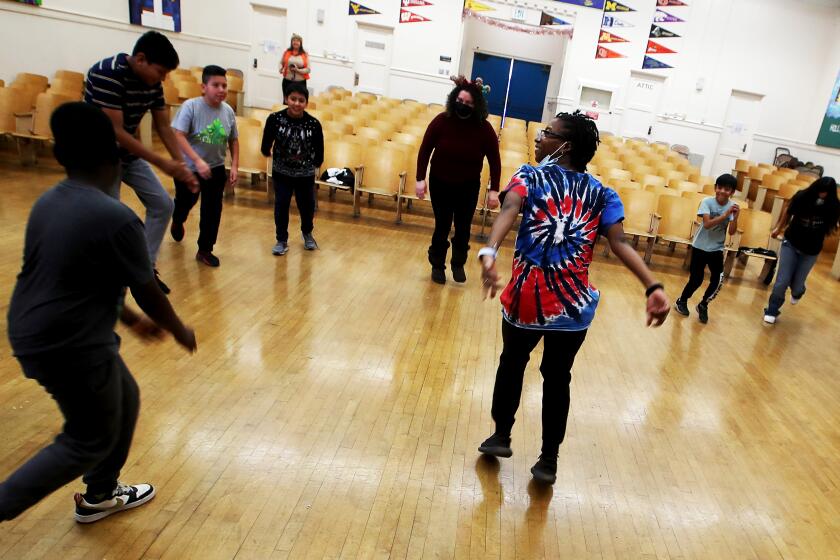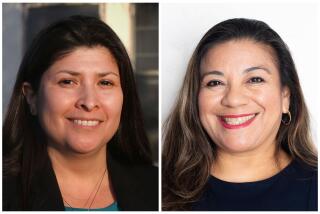Supt. Carvalho moves ahead with troubled AI effort despite collapse of tech contractor

- Share via
Los Angeles schools Supt. Alberto Carvalho said he is moving foward with his venture into artificial intelligence — a platform designed to help students and families navigate the complexities of the district — despite the collapse of the company that designed an AI chatbot.
In his first extended interview about what happened, the L.A. schools chief described a fully functional AI-driven platform that is in place and owned by the district — with everything but a chatbot for now.
But parents and teachers are questioning this characterization, because the platform is not available across the school system and its signature feature is sidelined. They said they have no idea how or how well it works, how to access it or what it is supposed to do. Their only information, they said, came from splashy media events.
One parent said he found personal information about his daughter online and questioned the district’s management of private data — although the district denies any connection between leaked data and the AI project or Boston-based AllHere, the company that designed the chatbot.
L.A. Unified said a former district contractor neglected to delete private district data — as required — and this stranded data became exposed through a breach at a different company. The district has not responded in greater detail to questions about this breach, including what information was compromised or how many people were affected. No notification has been sent out to affected families.
Carvalho has touted the chatbot, named “Ed,” as able to answer school-related questions from faculty, parents and students by drawing from all district databases — meaning that the automated platform is collecting, processing and sending out enormous amounts of data from the nation’s second-largest school system.
Officials said the chatbot has been deactivated since June 14, when they learned that AllHere had laid off the “vast majority” of its employees, as an AllHere company manager said in an email.
The district had paid AllHere $3 million for completed work in a contract for up to $6 million over five years.
“I want to be very clear about something: What was envisioned and promised — and I own the vision for this, I own it — was actually delivered,” Carvalho said.
“Ed is more than just a chatbot,” he added.
LAUSD sidelines “Ed,” an AI chatbot, after a splashy kick-off featuring a company that has now tanked. District also is dealing with another data breach.
Carvalho said the district will determine how to replace AllHere, assess potential risks related to AllHere’s collapse, and gradually roll out the AI platform to all schools, restoring the chatbot and adding to the functions of the system, which is still a work in progress.
Investigators working for the school system’s inspector general conducted a video interview on July 2 of Chris Whiteley, the former senior director of software engineering for AllHere, according to a report in The 74, an education news site. Whiteley has described in detail how his former employer allegedly violated both industry standards and the district’s own policies in its handling of student data.
Carvalho said he had no comment about Whiteley’s claims but said the district is aware of no data breach in connection with AllHere.
In published accounts, Whiteley has not alleged that a data breach took place — only that his former company’s practices created inappropriate risk.
AllHere did not respond to a request for comment.
“School of One”
Carvalho emphasized that the Ed platform was created as a vehicle for the creation of an Individual Acceleration Plan, or IAP, for every student.
In what he characterized as a groundbreaking achievement, Carvalho said an IAP would become a customized academic strategy. In a TEDTalk, Carvalho described the effort as a “school of one” for each student.
“Ed was envisioned as an individualized acceleration platform that uses all the data we have for students, all the partners we have in terms of curriculum, support, all the attendance data, everything about that child and is able to crunch that data, analyze it, and then generate a plan for that student. AI does that,” Carvalho told The Times.
“The chatbot is but one small feature,” he said. “It’s, by the way, the most exciting one because it’s what people identify AI as being, but foolish is the person that substitutes IAP for the chatbot.”
“A chatbot is nothing but a vehicle of communication. IAP is something much bigger.”
It was the chatbot, however, that was the star of the show — both in Carvalho’s address to open the prior school year and in a high-profile official launch in March.
The chatbot was represented visually as a grinning sun — often wearing sunglasses.
Late additions to the Los Angeles Unified School District budget protect jobs and benefits and add arts instruction. Police funding stays about the same.
After learning of the problems at AllHere, “we made the decision within days to — and this moved very, very quickly — to actually disable the chatbot,” Carvalho said. “No concerns over whether the chatbot would work or not. It works. Our concerns were over something that was very important to me: my demand, which was that a human would be in the loop always. And considering the staff cuts that we learned had taken place, we wanted to err on the side of caution.”
By “human in the loop” Carvalho was referring to human supervision over what the automated chatbot would be doing and saying. District officials have not clarified how much supervision would have been provided from AllHere, a small company with other clients and other products.
Ongoing maintenance of the system also was an issue, Carvalho said.
“Until such time as there’s stabilization regarding the back-of-the-house support, that feature will be disabled,” Carvalho said.
Without the chatbot, the Ed landing page is more like a traditional online resource — updated and expanded — with links and drop boxes.
Invisible acceleration plan
The Individual Acceleration Plan is not a report that can be printed out or viewed online.
Deputy Supt. Karla Estrada explained in an interview that the IAP is actually invisible to the user.
The IAP will exist in the background and be the basis for making computer-generated academic recommendations to a student, offering reading suggestions or math topics to work on.
“It’s not like a traditional plan where it’s written down and it’s flat on a piece of paper,” Estrada said. “It’s supposed to be dynamic with the student, and based on their needs as well as the ongoing data on performance.”
She added: “The thing is that students don’t want to feel like they are being put on a performance plan. They don’t want to feel that way. They want to receive that information, know what they need to do to improve, but they don’t want to see: ‘You are below level in these areas. So you need to get better.’ They want to understand: ‘How do I just keep getting better.’”
Widespread concerns
There is broad confusion over what the Ed system would enhance or replace.
The district, for example, has a parent portal and a separate site where students log on for schoolwork and communication with teachers. Will Ed replace these sites, or add one more layer before users get to the place they need to go?
What Ed can and cannot do remains murky.
An example cited in March by Carvalho was the ability to use Ed to track one’s school bus and its estimated arrival time. And Ed would offer a friendly nudge if a student was recently late for the bus. But Ed can’t do those things yet.
That functionality is “in the queue” of things to do, Estrada said. The district has not provided a list of things that Ed can or can’t do yet.
Carvalho and his team face significant challenges.
Student cellphone use at L.A. public schools will be banned starting in January to improve learning, limit distractions and decrease cyberbullying.
District officials said Ed was rolled out initially this spring to the district’s 100 most “fragile” schools — an attempt to provide the new benefit where it most was needed to help with academics, attendance and mental health issues.
But that means the vast majority of nearly 1,000 campuses and more than 400,000 students don’t have it.
“We have heard nothing other than the announcement in the media a few months ago,” said teacher Kim Knapp Soderstrom. “No information, explanations or trainings.”
“As far as I know, our school is not using this AI portal/platform,” said Jennifer Buscher, an elementary school parent at a school in Westchester. “I haven’t heard anything.”
Evelyn Aleman, who coordinates gatherings for Our Voice, which serves Spanish-speaking, low-income parents, said her participants “say they don’t know a thing about tech-driven portals, programs, AI, chatbots, etc. Even parents who are parent-center leads are telling me they don’t know a thing about this.
“It’s like we’re living in two distinct universes with LAUSD: one in which district leaders announce technological advances to great fanfare, and the other where Latino and Indigenous immigrant parents ... are still trying to access and learn basic new technologies and advocate for more urgent issues like literacy, more mental health resources, and school safety — among others.”
Carvalho and his team insist that Ed — with a purported ability to manage 100 languages — will make meaningful engagement easier.
Parent Elizabeth Bannister, who also has received no information from the district, said she’s concerned about the possibility of data breaches.
Parent and general contractor Steve Regen said he found private information about his daughter on the dark web.
“I really could care less that this information came from ‘a cloud storage device that was managed by a former third-party vendor,’” he wrote in an email to district officials. “What I do care about is that the LAUSD freely gave this ‘vendor’ full, unfettered access to our children’s information.”
Regen said the IT team he works with found the full names, birth dates and home address and all phone numbers and email addresses associated with LAUSD registration for his daughter and her friends.
“Parents deserve to be told of the seriousness of the breach to protect their children,” he told The Times.
In a general response the district told Regen: “We are working to determine what information was involved in this incident and if we determine that it involved anyone’s personal information, we will provide notifications to those individuals in accordance with applicable law.”
In a statement, district officials said they have cooperated with investigators and follow the highest standards for data protection.
More to Read
Sign up for Essential California
The most important California stories and recommendations in your inbox every morning.
You may occasionally receive promotional content from the Los Angeles Times.














